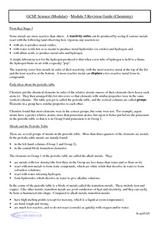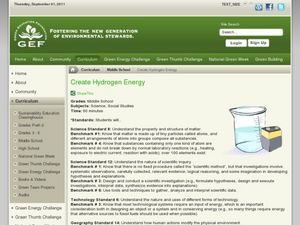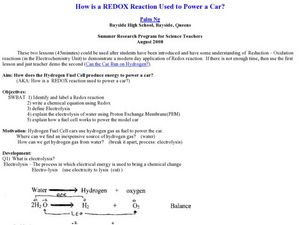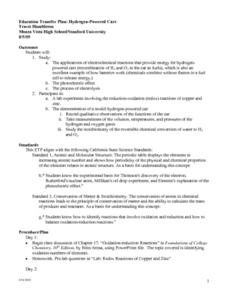Curated OER
Module 5 Revision Guide - Chemistry
If you use this as an outline for your chemistry lecture on metals, your young chemists will absorb a well-rounded overview. This is not a worksheet per se, but a useful summary of the behavior of metals. Save yourself some planning and...
Curated OER
Create Hydrogen Energy
Students complete an experiment to understand changes to the environment over time. In this hydrogen lesson plan, students discuss electrolysis and conduct an electrolysis experiment. Students observe and record their...
Curated OER
Hydrogen-Electrolysis of Water
Students discover how hydrogen is created and extracted from water to use as an energy source. In this solar energy lesson, students use pieces of aluminum foil as electrodes. Students attach one end of a wire to the hanger of the...
Curated OER
How is a REDOX Reaction Used to Power a Car?
Learners explore electrolysis and Redox reactions. In this exploratory lesson students demonstrate an example of electrolysis and how it brings on a chemical change.
Curated OER
THe Decomposition of Water
High schoolers collaborate in an experiment where they decompose water into simpler substances through the process of electrolysis. They collect, measure, and observe data and then place the data into a table. Accomodations for...
Curated OER
2004 U.S. National Chemistry Olympiad Exam Part II
In this National Chemistry Olympiad test, junior chemists answer eight problem solving questions on a variety of topics. These include calculating molarity of solutions, determining rates of reactions, calculating decay and discussing...
PHET
Generator
Michael Faraday was self-educated, earned an honorary doctorate from the University of Oxford, invented the first Bunsen burner, discovered the laws of electrolysis, and proved that a changing magnetic field produces a current. In this...
Curated OER
High School Chemistry Questions
In this chemistry instructional activity, students determine the number of water molecules is a given volume of water. Students determine the empirical formula for given compounds from the percentage mass of elements. This instructional...
Curated OER
Corrosion/Plating/Electrolysis
Students familiarize themselves with half cell reactions, potential circuits, etc. They participate in a lab that includes a worksheet that guides them through an inquiry pertaining to the content. They complete a series of questions...
American Chemical Society
Energy Foundations
Only 10 percent of an incandescent bulb's energy is used to create light; the remaining 90 percent is heat. In the unit of activities, young chemists examine energy through hands-on activities, videos, discussions, and...
Biology Junction
Water Properties and More
Did you know many insects use cohesion or surface tension to walk on water? Using a presentation, scholars learn the more important properties of water. It extends into the concepts of solutions, suspensions, pH, and more.
Curated OER
Hydrogen- The Fuel of the Future
Learners research the importance of Hydrogen as a potential fuel source. They work in groups to used the internet in order to research this topic. They participate in an electrolysis experiment and a power point presentation in order...
Texas State Energy Conservation Office
Fueling the Future
Future mechanical engineers and automotive technicians read about various solutions to using gasoline in cars. Included are electric, fuel-cell-powered, and hybrid vehicles.
Curated OER
Construction of a Microscale Fuel Cell
Fuel cells are being called the "energy source" of the future. Allow your high school chemistry class to construct a miscroscale fuel cell, complete with all components to generate energy. This engaging activity will allow them to apply...
Curated OER
Bond Energies
Before completing this learning exercise, chemists are supposed read a portion of their textbook. Assign the chapter on bond energies, endothermic, and exothermic reactions. Then have your class answer the questions and fill in the data...
Cornell University
Splitting Water with Electricity
Explore how electricity splits water molecules into hydrogen and oxygen. Learners begin by calculating the voltage necessary to separate the water. They then perform the experiment and measure the ratio of hydrogen and oxygen bubbles.
Curated OER
BioTechnology
The concept of electrophoresis and how it can be used to track sections of DNA that have been spliced is introduced in this slideshow. There are a few grammatical and spelling errors, but overall the slides are nicely presented.
Curated OER
Aluminum and Titanium
Comparing aluminum and titanium, this PowerPoint gives the physical and chemical properties of each. Illustrations are used to assist in understanding. The notes are succinct, making this information a great model for chemistry or earth...
Curated OER
Answer Key for More Advanced Electrochemistry Calculations
In this electrochemistry activity, students solve 9 problems such as identifying masses of metals produced at cathodes, determining the potential of a cell's electrode and writing cell reactions along with their potential.
Curated OER
Hydrogen Powered Cars
Young scholars apply the principles of chemistry to investigate the concept of how a hydrogen powered car works. They study the electrochemical reactions that provide the energy source. Students also record observations in the...
Curated OER
Early Atomic Theory Homework
For this early atomic theory worksheet, students answer 4 questions about the Law of Definite Proportions, the Law of Conservation of Mass and Dalton's Laws. Students are given 5 statements to determine if each true statement supports or...
Curated OER
ABCs of Hydrogen and Fuel Cells
Young scholars are introduced to the concept of hydrogen technologies through inquiry-based classroom activities.
Curated OER
Chemistry Quiz 4-Redox Reactions
In this oxidation/ reduction worksheet, students solve eight multiple choice problems related to redox reactions. They determine half reactions, they calculate standard cell potentials, they identifying oxidizing and reducing agents and...
Curated OER
Separation of Mixtures and Compounds For K Through 12
Students explore mixtures and compounds. In this instructional activity, students do an experiment to distinguish between mixtures and compounds. Students complete ten different phases of the experiment testing many different substances....
Other popular searches
- Electrolysis of Water
- Electrolysis Copper
- Catalyst and Electrolysis
- Electrolysis Copper Sulphate
- Chemistry Electrolysis
- Electrolysis Water
- Experiment Electrolysis
- Electrolysis Lab
- Hoffman Electrolysis
- Hofmann Electrolysis
- Electrolysis of Copper
- Electrolysis of Aluminium























